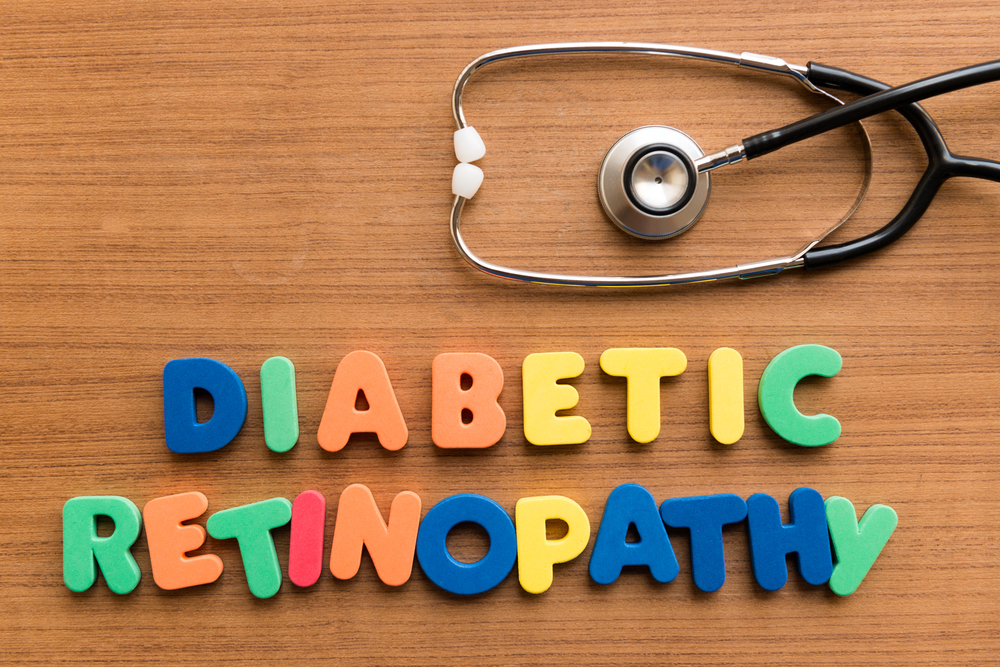Overview
Diabetic retinopathy is a diabetes-induced medical complication that occurs when high blood sugar levels damage the back of the eye( retina).
At first, diabetic retinopathy may show no symptoms or cause only mild vision. It takes years to cause problems with your eyesight, but it can eventually lead to blindness.
Anyone who already manages type 1 or 2 diabetes can develop diabetic retinopathy. The longer you have diabetes, and the less controlled your blood sugar is, you will likely develop this eye complication.
Key facts
- Diabetic retinopathy (DR) is when high blood sugar levels damage the vessels carrying blood to the retina.
- The retina is a network of cells that converts and transmits light as electrical signals to the brain.
- Consistent high sugar levels can damage the vessels carrying blood to the retina.
- Symptoms of DR include blurred vision, eye bleeds, difficulty seeing colours, floaters, and sudden vision loss.
- People with diabetes should have their eyesight evaluated at least once every year to rule out diabetic retinopathy.
- Retinal surgeries can relieve symptoms, but controlling diabetes and managing early signs are the most effective ways to prevent DR.
Symptoms
Diabetic retinopathy can take years before it shows any symptoms. The condition will often be advanced before it presents any symptoms. On occasion, the only noticeable sign is a sudden and complete vision loss.
Symptoms of diabetic retinopathy may include:
- Blurred vision
- Inability to see colour
- Floaters, or transparent and colourless spots and dark strings that float in the patient’s field of vision
- Patches or streaks that block the person’s vision
- Poor night vision
- Sudden and total loss of vision
Diagnosis
Dilated eye exam: This examination is painless and straightforward. Your doctor will administer eye drops to your eyes. This would cause them to dilate (widen), allowing the doctor to view the inside of the eye in a more detailed way. By doing so, the doctor can detect if there are;
- Irregularities in the blood vessels, optic nerve, or retina
- Cataracts
- Changes in eye pressure or overall vision
- New blood vessels
- Retinal detachment
- Scar tissue
Fluorescein angiography: Drops are also used to dilate the pupils in this eye examination. Then, a distinct dye, fluorescein, is administered intravenously to the patient’s arm. Images of the eye are taken as the dye circulates through the eyes. If the dye leaks into the retina or stains the blood vessels, it is a pointer to an abnormality.
Optical coherence tomography (OCT): This new noninvasive and powerful imaging scan provides high-resolution cross-sectional images of the retina, revealing its thickness. After treatments, scans may be used later to check how effective treatment has been.
Causes
Diabetic retinopathy is caused by damage to the network of blood vessels that nourish the retina.
High blood sugar levels damage these vessels, restricting blood flow to the cells (retina) that transmit visual signals to the brain.
When there’s too much glucose in the blood, the blood vessels that carry blood to the optic nerve can begin to leak blood occasionally. However, this can go on without affecting vision. When it reaches the advanced stages, the sugar completely blocks the blood vessels, forcing the eye to produce new but weaker and less stable ones. These new vessels break easily and leak into the eye’s vitreous gel. The bleeding causes blurred and patchy vision by further blocking the retina.
Prevention
- Manage your diabetes. Prioritise healthy eating and physical activity, which should be a part of your daily routine. Your goal should be to get at least 150 minutes of aerobic exercise. These should include moderate activities such as walking, cycling or swimming each week. Also, be consistent with taking your oral diabetes medications or insulin as directed by your doctor.
- Monitor your blood sugar level. You should monitor and record your blood sugar level several times daily — more frequent measurements may be required if you are stressed or ill. Your doctor will direct you on how often you need to check your blood sugar.
- Take a glycosylated haemoglobin test. The Haemoglobin A1C test (or glycosylated haemoglobin test) shows your average blood sugar level for two to three months before the test. For most people, the A1C goal is under 7 per cent.
- Reduce your blood pressure and cholesterol. Exercising regularly, eating healthy, and shedding excess weight can help. You might need medication as well.
- Try quitting smoking and tobacco usage. Smoking puts you at risk of developing several diabetes complications, including diabetic retinopathy.
- Pay attention to vision changes. See your eye doctor immediately if you experience sudden vision changes or become blurry, spotty, or hazy.
Treatment
Treatment for diabetic retinopathy depends on various factors, including how advanced the condition is and how it responds to previous therapies.
During its early stages, a doctor may only monitor the person’s eyes closed without applying any treatment therapy.
Patients will need to focus on reducing their blood sugar level with the assistance of their healthcare giver. Maintaining healthy blood sugar control can significantly reduce the risk and slow down the development of diabetic retinopathy.
In some cases, the individual may require laser surgery to correct vision loss:
Treatment options include;
Laser treatment
This is a surgical operation where the doctor uses targeted lasers to shrink blood vessels in the eye and close the leaks from irregular blood vessels.
This treatment can either slow down or stop blood leakage and reduce fluid buildup in the eye.
More than one session of this treatment may be needed.
The doctor will apply anaesthesia to the eye during the procedure and then aim an intense beam of laser light into the eye using a unique lens.
Because the light is bright and strong, it may sting or hurt for a bit. After the procedure, patients may experience blurriness in their vision for the rest of the day.
The patient might experience tiny spots in their vision for a few weeks after laser treatment.
It is worth of note that this procedure is not without certain risks. Some of them include loss of peripheral vision, colour vision, and night vision. Talk to your doctor about the relative benefits and risks of this treatment.
Injections
Some specific medicines can reduce fluid buildup and minimise leakage from blood vessels in the eyes. They may include anti-VEGF drugs and corticosteroids.
People with DR may need to get regular injections. However, the frequency will reduce as the medicines begin to take effect.
Eye surgery
If a person with diabetic retinopathy may also benefit from getting a vitrectomy.
This surgical procedure involves the removal of some of the vitreous substances from the eye.
It is good to note that surgery is not a fix-all solution for diabetic retinopathy, but it may stop or slow down the condition’s advancement. If your blood sugar levels are consistently high, subsequent retinal damage and vision loss may still occur despite treatment.
Conclusion
Diabetic retinopathy is a complication of diabetes that develops when high glucose in the blood damages the network of blood vessels that supply nourishment to the cells at the back of the eye (retina).
Though it usually takes several years for diabetic retinopathy to reach this stage, it can cause complete vision loss if left untreated.
To prevent this from happening and minimise the risk, people living with diabetes should:
Make sure they control their blood sugar levels, blood pressure and cholesterol.
Go to their eye doctor for diabetic eye screening appointments annually.
MOST COMMON







